纳米防晒霜
化妆品中纳米材料的应用与评估
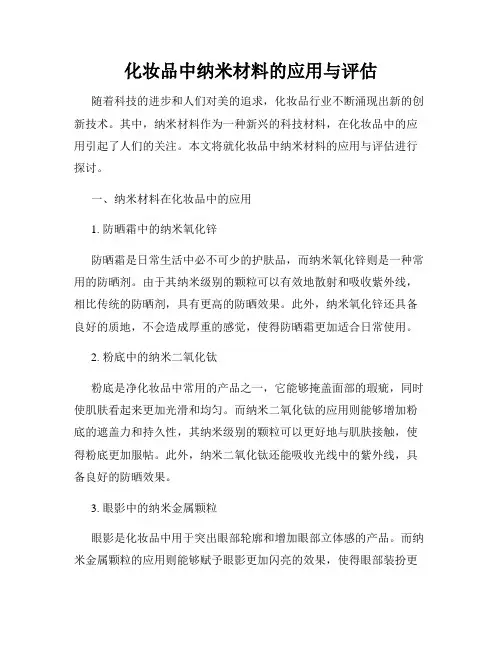
化妆品中纳米材料的应用与评估随着科技的进步和人们对美的追求,化妆品行业不断涌现出新的创新技术。
其中,纳米材料作为一种新兴的科技材料,在化妆品中的应用引起了人们的关注。
本文将就化妆品中纳米材料的应用与评估进行探讨。
一、纳米材料在化妆品中的应用1. 防晒霜中的纳米氧化锌防晒霜是日常生活中必不可少的护肤品,而纳米氧化锌则是一种常用的防晒剂。
由于其纳米级别的颗粒可以有效地散射和吸收紫外线,相比传统的防晒剂,具有更高的防晒效果。
此外,纳米氧化锌还具备良好的质地,不会造成厚重的感觉,使得防晒霜更加适合日常使用。
2. 粉底中的纳米二氧化钛粉底是净化妆品中常用的产品之一,它能够掩盖面部的瑕疵,同时使肌肤看起来更加光滑和均匀。
而纳米二氧化钛的应用则能够增加粉底的遮盖力和持久性,其纳米级别的颗粒可以更好地与肌肤接触,使得粉底更加服帖。
此外,纳米二氧化钛还能吸收光线中的紫外线,具备良好的防晒效果。
3. 眼影中的纳米金属颗粒眼影是化妆品中用于突出眼部轮廓和增加眼部立体感的产品。
而纳米金属颗粒的应用则能够赋予眼影更加闪亮的效果,使得眼部装扮更加出彩。
纳米金属颗粒的小尺寸使其能够散射光线,并且形成多角度的反射,使眼影看起来更加炫目。
因此,含有纳米金属颗粒的眼影成为了时下流行的化妆品之一。
二、纳米材料在化妆品中的评估尽管纳米材料在化妆品中的应用带来了许多优势,但其中也存在一些值得关注的问题。
为了保障使用者的安全和合规性,对化妆品中的纳米材料进行评估是十分必要的。
1. 毒性评估纳米材料的特殊尺寸和表面性质可能导致其在生物体内的行为和作用发生改变,可能导致毒性效应。
因此,对纳米材料在化妆品中的使用,需要开展相关的毒性评估研究,确定其对皮肤和身体的安全性,以减少潜在的风险。
2. 生物可利用性评估纳米材料在化妆品中的应用需要对其生物可利用性进行评估。
这包括了纳米材料在皮肤上的吸收情况以及是否对人体产生任何不良反应。
通过研究纳米材料在皮肤中的吸收速度、分布方式和排泄情况,可以更好地了解其在化妆品中的应用是否安全和有效。
化妆品中的新型防晒剂研究
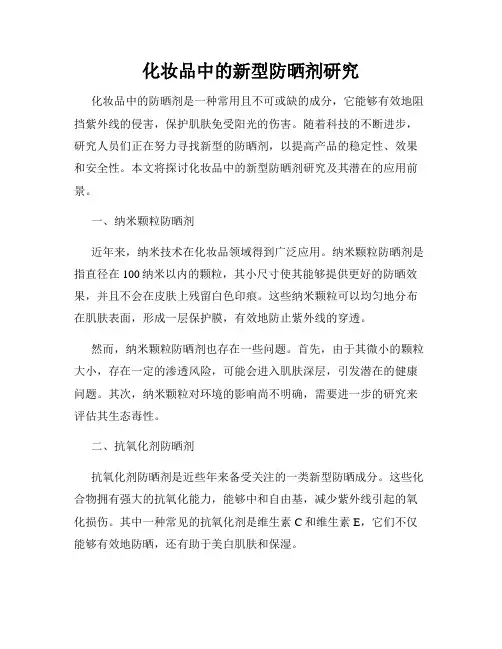
化妆品中的新型防晒剂研究化妆品中的防晒剂是一种常用且不可或缺的成分,它能够有效地阻挡紫外线的侵害,保护肌肤免受阳光的伤害。
随着科技的不断进步,研究人员们正在努力寻找新型的防晒剂,以提高产品的稳定性、效果和安全性。
本文将探讨化妆品中的新型防晒剂研究及其潜在的应用前景。
一、纳米颗粒防晒剂近年来,纳米技术在化妆品领域得到广泛应用。
纳米颗粒防晒剂是指直径在100纳米以内的颗粒,其小尺寸使其能够提供更好的防晒效果,并且不会在皮肤上残留白色印痕。
这些纳米颗粒可以均匀地分布在肌肤表面,形成一层保护膜,有效地防止紫外线的穿透。
然而,纳米颗粒防晒剂也存在一些问题。
首先,由于其微小的颗粒大小,存在一定的渗透风险,可能会进入肌肤深层,引发潜在的健康问题。
其次,纳米颗粒对环境的影响尚不明确,需要进一步的研究来评估其生态毒性。
二、抗氧化剂防晒剂抗氧化剂防晒剂是近些年来备受关注的一类新型防晒成分。
这些化合物拥有强大的抗氧化能力,能够中和自由基,减少紫外线引起的氧化损伤。
其中一种常见的抗氧化剂是维生素C和维生素E,它们不仅能够有效地防晒,还有助于美白肌肤和保湿。
抗氧化剂防晒剂的优点是稳定性强,不会因为光照或热力而降解,具有较长的有效期。
然而,由于抗氧化剂的性质,其防晒能力相对较弱,需要与其他防晒剂结合使用,以提供更好的保护。
三、生物衍生物防晒剂随着对自然性和健康性的追求,生物衍生物防晒剂在近年来受到越来越多的关注。
这些防晒成分是从植物或海洋生物中提取的,具有天然的抗氧化和防晒能力。
例如,葡萄籽提取物和海藻提取物都被证明具有良好的防晒效果。
生物衍生物防晒剂的优势在于其较低的过敏性和皮肤刺激性。
然而,由于其天然性质,其稳定性和防晒效果与合成化合物相比可能稍逊一筹。
因此,综合考虑产品的稳定性和效果,常常需要将生物衍生物防晒剂与其他防晒剂混合使用。
四、未来展望随着对防晒产品的需求不断增加,新型防晒剂的研究也在不断推进。
未来,我们可以预见以下几个方向的发展趋势。
纳米化妆品
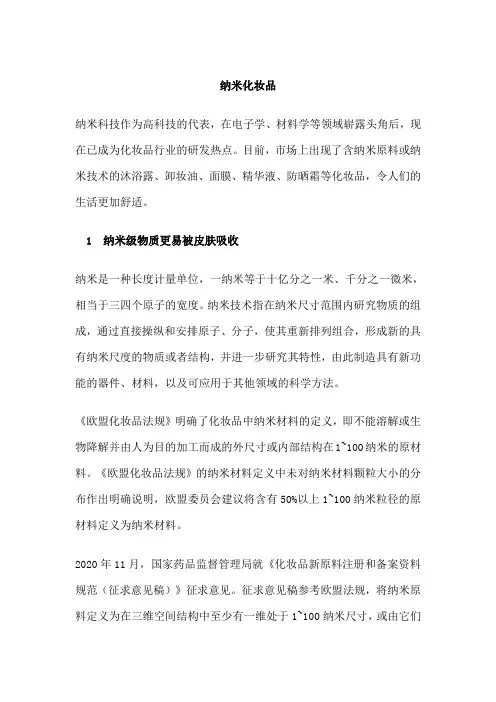
纳米化妆品纳米科技作为高科技的代表,在电子学、材料学等领域崭露头角后,现在已成为化妆品行业的研发热点。
目前,市场上出现了含纳米原料或纳米技术的沐浴露、卸妆油、面膜、精华液、防晒霜等化妆品,令人们的生活更加舒适。
1纳米级物质更易被皮肤吸收纳米是一种长度计量单位,一纳米等于十亿分之一米、千分之一微米,相当于三四个原子的宽度。
纳米技术指在纳米尺寸范围内研究物质的组成,通过直接操纵和安排原子、分子,使其重新排列组合,形成新的具有纳米尺度的物质或者结构,并进一步研究其特性,由此制造具有新功能的器件、材料,以及可应用于其他领域的科学方法。
《欧盟化妆品法规》明确了化妆品中纳米材料的定义,即不能溶解或生物降解并由人为目的加工而成的外尺寸或内部结构在1~100纳米的原材料。
《欧盟化妆品法规》的纳米材料定义中未对纳米材料颗粒大小的分布作出明确说明,欧盟委员会建议将含有50%以上1~100纳米粒径的原材料定义为纳米材料。
2020年11月,国家药品监督管理局就《化妆品新原料注册和备案资料规范(征求意见稿)》征求意见。
征求意见稿参考欧盟法规,将纳米原料定义为在三维空间结构中至少有一维处于1~100纳米尺寸,或由它们作为基本单元构成的不溶和生物不可降解的人工材料。
纳米化妆品是采用纳米级原料或应用纳米技术生产的化妆品。
纳米化妆品的技术原理是什么呢?当物质被分解成纳米微粒时通常会展现出新的活跃特性。
举例来说,已有研究证实,某些矿物质,如被广泛应用于防晒化妆品中的氧化锌,其处于自然状态时,是白色的油脂状;其被分解成纳米微粒时,会转变成透明且更易被皮肤吸收的状态。
经常被用于护发素和卸妆液中的乳化剂,在被分解成纳米微粒时,其油性有所减弱,对头发和皮肤的作用更加明显。
纳米化妆品的技术原理可形象地描述为:人体表皮细胞的间隙为头发丝粗细的十分之一,纳米微粒则为头发丝粗细的几万分之一,远远小于皮肤间隙,因此纳米级物质能更自由地渗入皮肤细胞,其有效成分也更易被皮肤吸收。
纳米技术新产品介绍
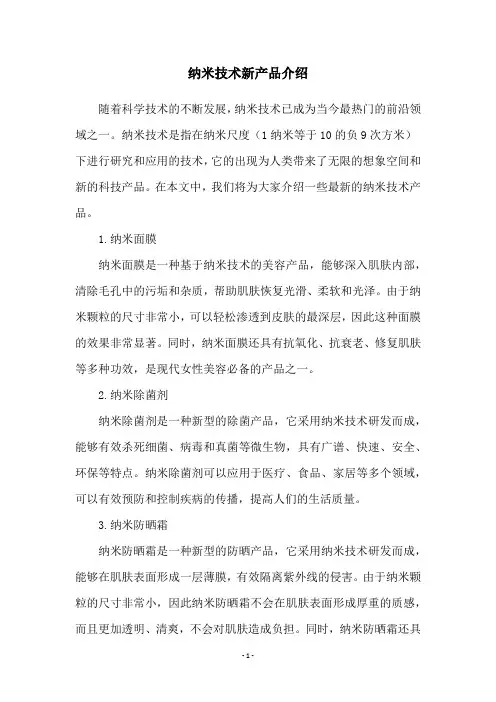
纳米技术新产品介绍随着科学技术的不断发展,纳米技术已成为当今最热门的前沿领域之一。
纳米技术是指在纳米尺度(1纳米等于10的负9次方米)下进行研究和应用的技术,它的出现为人类带来了无限的想象空间和新的科技产品。
在本文中,我们将为大家介绍一些最新的纳米技术产品。
1.纳米面膜纳米面膜是一种基于纳米技术的美容产品,能够深入肌肤内部,清除毛孔中的污垢和杂质,帮助肌肤恢复光滑、柔软和光泽。
由于纳米颗粒的尺寸非常小,可以轻松渗透到皮肤的最深层,因此这种面膜的效果非常显著。
同时,纳米面膜还具有抗氧化、抗衰老、修复肌肤等多种功效,是现代女性美容必备的产品之一。
2.纳米除菌剂纳米除菌剂是一种新型的除菌产品,它采用纳米技术研发而成,能够有效杀死细菌、病毒和真菌等微生物,具有广谱、快速、安全、环保等特点。
纳米除菌剂可以应用于医疗、食品、家居等多个领域,可以有效预防和控制疾病的传播,提高人们的生活质量。
3.纳米防晒霜纳米防晒霜是一种新型的防晒产品,它采用纳米技术研发而成,能够在肌肤表面形成一层薄膜,有效隔离紫外线的侵害。
由于纳米颗粒的尺寸非常小,因此纳米防晒霜不会在肌肤表面形成厚重的质感,而且更加透明、清爽,不会对肌肤造成负担。
同时,纳米防晒霜还具有保湿、修复肌肤等功效,是夏季户外活动必备的防护产品。
4.纳米智能材料纳米智能材料是一种新型的功能材料,它采用纳米技术制备而成,具有智能控制、高效转换、多功能等特点。
纳米智能材料可以广泛应用于电子、能源、环保等多个领域,可以有效解决现代社会面临的各种问题,推动社会进步和发展。
总之,纳米技术已成为当今最热门的前沿领域之一,其应用范围非常广泛,涉及医疗、美容、防护、环保等多个领域。
随着纳米技术的不断发展和完善,相信未来还会有更多的纳米技术产品问世,为人类带来更多的福利和惊喜。
纳米材料在化妆品中的应用前景
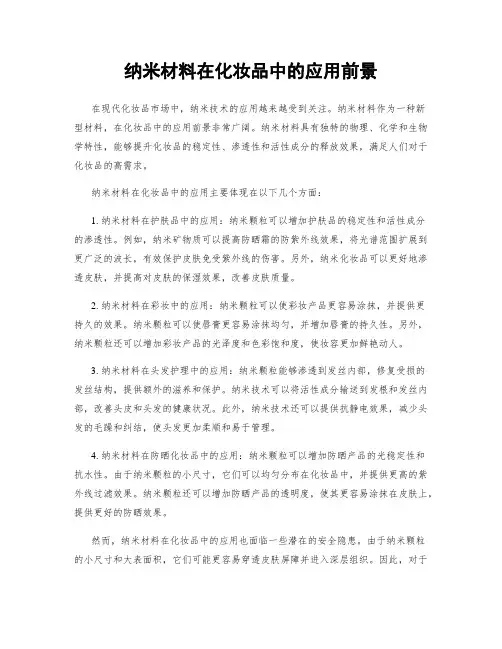
纳米材料在化妆品中的应用前景在现代化妆品市场中,纳米技术的应用越来越受到关注。
纳米材料作为一种新型材料,在化妆品中的应用前景非常广阔。
纳米材料具有独特的物理、化学和生物学特性,能够提升化妆品的稳定性、渗透性和活性成分的释放效果,满足人们对于化妆品的高需求。
纳米材料在化妆品中的应用主要体现在以下几个方面:1. 纳米材料在护肤品中的应用:纳米颗粒可以增加护肤品的稳定性和活性成分的渗透性。
例如,纳米矿物质可以提高防晒霜的防紫外线效果,将光谱范围扩展到更广泛的波长,有效保护皮肤免受紫外线的伤害。
另外,纳米化妆品可以更好地渗透皮肤,并提高对皮肤的保湿效果,改善皮肤质量。
2. 纳米材料在彩妆中的应用:纳米颗粒可以使彩妆产品更容易涂抹,并提供更持久的效果。
纳米颗粒可以使唇膏更容易涂抹均匀,并增加唇膏的持久性。
另外,纳米颗粒还可以增加彩妆产品的光泽度和色彩饱和度,使妆容更加鲜艳动人。
3. 纳米材料在头发护理中的应用:纳米颗粒能够渗透到发丝内部,修复受损的发丝结构,提供额外的滋养和保护。
纳米技术可以将活性成分输送到发根和发丝内部,改善头皮和头发的健康状况。
此外,纳米技术还可以提供抗静电效果,减少头发的毛躁和纠结,使头发更加柔顺和易于管理。
4. 纳米材料在防晒化妆品中的应用:纳米颗粒可以增加防晒产品的光稳定性和抗水性。
由于纳米颗粒的小尺寸,它们可以均匀分布在化妆品中,并提供更高的紫外线过滤效果。
纳米颗粒还可以增加防晒产品的透明度,使其更容易涂抹在皮肤上,提供更好的防晒效果。
然而,纳米材料在化妆品中的应用也面临一些潜在的安全隐患。
由于纳米颗粒的小尺寸和大表面积,它们可能更容易穿透皮肤屏障并进入深层组织。
因此,对于纳米材料的安全性研究至关重要。
相关机构和研究人员应该加强对纳米材料的风险评估,确保其安全使用。
此外,还需要加强对纳米材料在环境中的影响的研究。
一旦纳米材料进入水体或土壤中,其对环境的潜在影响仍不明确。
因此,制定严格的规定和标准,确保纳米材料的合理使用和环境友好性也是十分重要的。
纳米化妆品法规
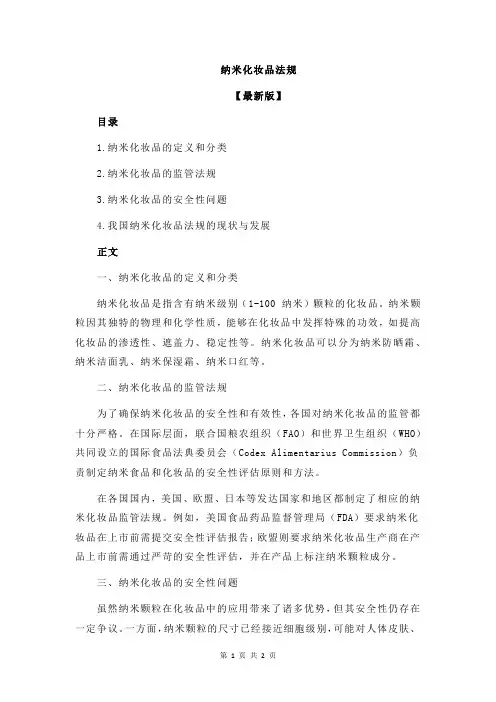
纳米化妆品法规【最新版】目录1.纳米化妆品的定义和分类2.纳米化妆品的监管法规3.纳米化妆品的安全性问题4.我国纳米化妆品法规的现状与发展正文一、纳米化妆品的定义和分类纳米化妆品是指含有纳米级别(1-100 纳米)颗粒的化妆品。
纳米颗粒因其独特的物理和化学性质,能够在化妆品中发挥特殊的功效,如提高化妆品的渗透性、遮盖力、稳定性等。
纳米化妆品可以分为纳米防晒霜、纳米洁面乳、纳米保湿霜、纳米口红等。
二、纳米化妆品的监管法规为了确保纳米化妆品的安全性和有效性,各国对纳米化妆品的监管都十分严格。
在国际层面,联合国粮农组织(FAO)和世界卫生组织(WHO)共同设立的国际食品法典委员会(Codex Alimentarius Commission)负责制定纳米食品和化妆品的安全性评估原则和方法。
在各国国内,美国、欧盟、日本等发达国家和地区都制定了相应的纳米化妆品监管法规。
例如,美国食品药品监督管理局(FDA)要求纳米化妆品在上市前需提交安全性评估报告;欧盟则要求纳米化妆品生产商在产品上市前需通过严苛的安全性评估,并在产品上标注纳米颗粒成分。
三、纳米化妆品的安全性问题虽然纳米颗粒在化妆品中的应用带来了诸多优势,但其安全性仍存在一定争议。
一方面,纳米颗粒的尺寸已经接近细胞级别,可能对人体皮肤、神经系统等产生潜在的影响。
另一方面,纳米颗粒在环境中的释放和降解可能对生态环境产生负面影响。
四、我国纳米化妆品法规的现状与发展我国对纳米化妆品的监管也日益严格。
目前,我国已发布了《化妆品安全技术规范》(GB/T 29680-2013)等一系列法规和标准,对纳米化妆品的原料、生产工艺、安全性评估等方面进行了规定。
此外,我国政府也积极参与国际纳米化妆品法规的制定,以加强与其他国家和地区的交流与合作。
总体来看,纳米化妆品作为化妆品行业的一个新兴领域,其监管法规和安全性评估仍在不断完善和发展。
纳米生活中的例子
纳米生活中的例子纳米生活是指在纳米尺度下的生活方式和应用。
纳米技术的发展已经渗透到人们的日常生活中,带来了许多改变和便利。
下面列举了10个纳米生活的例子。
1. 纳米防晒霜:纳米颗粒能够使防晒霜更容易被皮肤吸收,提供更好的防晒效果。
同时,纳米颗粒能够使防晒霜更加透明,不会在皮肤上留下白色痕迹。
2. 纳米洗衣液:纳米颗粒在洗涤过程中能够更好地渗透到衣物纤维中,去除污渍,使衣物更干净。
同时,纳米洗衣液还可以抑制细菌繁殖,保持衣物的清洁和卫生。
3. 纳米空气净化器:纳米材料能够吸附和分解空气中的有害物质,如甲醛、苯等。
纳米空气净化器能够提供更好的空气质量,保持室内空气清新。
4. 纳米面膜:纳米颗粒能够更好地渗透到皮肤深层,提供更好的滋养和保湿效果。
纳米面膜能够使皮肤更加光滑细腻,延缓皮肤老化。
5. 纳米健康监测器:纳米传感器能够检测人体的健康指标,如心率、血压等。
纳米健康监测器可以实时监测人体健康状况,提醒人们采取相应的健康措施。
6. 纳米食品包装:纳米材料能够延长食品的保质期,防止细菌和霉菌的生长。
纳米食品包装可以保持食品的新鲜和营养。
7. 纳米药物传递系统:纳米颗粒能够在体内精确地释放药物,减少药物的副作用。
纳米药物传递系统能够提高药物的治疗效果,减少药物的用量。
8. 纳米智能材料:纳米材料能够响应外界刺激,如光、温度等,实现智能控制。
纳米智能材料可以应用在智能家居、智能穿戴设备等领域。
9. 纳米电池:纳米材料能够提高电池的储能密度和充电速度。
纳米电池可以应用在移动设备、电动车等领域,提供更长的使用时间和更快的充电速度。
10. 纳米涂层:纳米涂层能够提高材料的耐磨、耐腐蚀等性能。
纳米涂层可以应用在汽车、建筑等领域,提供更好的保护和使用寿命。
这些例子只是纳米生活中的一小部分,纳米技术的应用还有很多潜力待发掘。
随着纳米技术的进一步发展,我们可以期待更多创新和改变带给我们的生活。
纳米防晒霜英语作文两百字
纳米防晒霜英语作文两百字Nanotech Sunscreen: A Revolutionary Approach to Sun Protection.In the realm of sun protection, the advent of nanotechnology has heralded a groundbreaking advancement: nanoformulated sunscreens. These innovative products leverage the unique properties of nanoparticles to offer unparalleled efficacy and benefits that surpass conventional chemical and mineral sunscreens.Nanoformulated sunscreens utilize nanoparticles, particles with sizes ranging from 1 to 100 nanometers, as their active ingredients. These nanoparticles are typically composed of inorganic materials such as zinc oxide or titanium dioxide, which inherently possess UV-absorbing properties. By reducing the particle size to the nanoscale, these sunscreens achieve remarkable sun protection while addressing the drawbacks of traditional formulations.Enhanced Sun Protection:The diminutive size of nanoparticles enables them to interact with UV radiation more effectively than larger particles. This increased surface area enhances their UV-absorbing capacity, resulting in superior sun protection. Nanoscale particles can effectively scatter, absorb, and reflect both UVA and UVB rays, providing broad-spectrum protection against the full range of harmful solar radiation.Improved Transparency:Conventional sunscreens often leave an unsightly white cast on the skin, particularly when applied in sufficient quantities to achieve adequate protection. This unappealing effect arises from the larger particle size of these formulations, which can scatter visible light. In contrast, nanoscale particles are too small to interact significantly with visible light, rendering them virtually transparent. Nanoformulated sunscreens can therefore provide high levels of sun protection without compromising aesthetics.Reduced Chemical Penetration:Chemical sunscreens rely on organic compounds that penetrate the skin to absorb UV radiation. However, some of these chemicals have raised concerns about potentialtoxicity and skin irritation. Nanoparticles, on the other hand, are designed to remain on the skin's surface, forming a physical barrier that deflects UV rays. This minimized chemical penetration reduces the risk of adverse reactions and ensures the safety of nanoformulated sunscreens.Broader Applications:Nanoformulated sunscreens offer unique advantages for a wider range of applications. They can be incorporated into clothing, cosmetics, and other products that are not traditionally associated with sun protection. This versatility extends their utility to situations where traditional sunscreen use is impractical or ineffective.In conclusion, nanoformulated sunscreens represent asignificant advancement in sun protection technology. Their enhanced efficacy, improved transparency, reduced chemical penetration, and broader applications make them a highly effective and convenient solution for protecting skin from the harmful effects of solar radiation. As research continues, the potential of nanotechnology in the realm of sunscreens is bound to expand even further, providing even greater protection and benefits for years to come.。
纳米科技在化妆品中的应用
纳米科技在化妆品中的应用化妆品作为人们日常生活中必不可少的消费品之一,一直以来受到广泛关注。
近年来,纳米科技的发展进一步推动了化妆品产业的进步。
纳米科技的应用让化妆品更加精致细腻,也更加安全。
本文将从纳米科技的基础概念、纳米化妆品的种类及其应用方面进行探讨。
一、纳米科技的基础概念纳米科技是指研究和应用物质在纳米尺度(一般为1至100纳米)下的物理、化学和生物学规律的科学技术。
纳米科技的基本概念是纳米尺度,意味着一些物理性质和化学性质发生了很大的变化,比如,光的吸收、散射和反射、表面化学反应的活性、磁性的强度等等。
纳米科技的发展对生物医学、能源、材料、环境等领域产生了巨大的影响。
二、纳米化妆品的种类及其应用1.纳米化妆品的种类纳米化妆品是一种通过纳米技术处理的化妆品。
目前,纳米化妆品的种类主要有以下几类:(1)纳米粉末化妆品。
如纳米二氧化钛、纳米氧化锌、纳米硅等,这些纳米粉末可以应用于防晒霜、粉底等化妆品中。
(2)纳米脂质体化妆品。
将具有生物活性的化合物通过纳米技术与脂质体相结合,从而起到强化、滋养、修复皮肤等功效。
纳米脂质体化妆品主要分为脂质体乳液、脂质体凝胶和脂质体乳霜等。
(3)纳米微囊化妆品。
将活性成分通过微囊技术包埋于微囊内部,以获得延长作用、渗透等效果。
纳米微囊化妆品主要分为晶质微囊、聚合物微囊、脂质微囊和无机微囊等。
2.纳米化妆品的应用(1)纳米粉末化妆品纳米粉末技术已应用于创新型防晒霜、化妆品粉底等。
在化妆品中,使用纳米二氧化钛和纳米氧化锌能起到增强防晒效果的作用。
纳米级氧化锌和氧化钛具有比普通氧化锌和氧化钛更强的光反射和抵御紫外线能力。
同时,由于纳米颗粒的小尺寸,能够使防晒霜制剂在肌肤上的透明度更高。
(2)纳米脂质体化妆品纳米脂质体化妆品采用的是纳米技术结合脂质体的优势,修护皮肤、保湿、深入渗透等效果突出。
举例来说,纳米脂质体乳液能够渗透进皮肤深层次进行滋养,并能够改善细纹、暗沉等问题。
纳米在生活中的运用
纳米在生活中的运用纳米技术是现代科学和工程领域的一个热门话题。
纳米尺度的物质具有与传统材料不同的性质和特征,这使得纳米技术拥有广泛的应用潜力。
在日常生活中,我们可以看到许多纳米技术的应用,下面是一些常见的例子:1.光电子显示屏:纳米技术被广泛应用于液晶显示器和有机发光二极管(OLED)等光电子显示屏的制造。
通过使用纳米材料,可以提高显示器的亮度、对比度和色彩饱和度。
2.防晒霜:纳米颗粒可以在防晒霜中用作物理性防晒剂,能够有效地吸收或散射紫外线(UV)辐射,进而保护皮肤不受损伤。
3.纳米衣物:通过纳米技术处理的纤维可以使衣物具有防污、防水和防菌的功能。
纳米纤维还可以制造高性能的运动服装,使其具有透气、吸湿和排汗的特性。
4.医疗诊断:纳米技术在医疗诊断中有广泛的应用。
纳米颗粒可以用作抗体标记,用于跟踪和定位病变细胞或病原体。
此外,纳米技术还可以用于开发更快速、敏感和准确的诊断方法。
5.药物传递系统:纳米技术在药物传递系统中具有巨大的潜力。
纳米颗粒可以用作药物的载体,将药物准确地送达到特定的组织或细胞。
这种针对性的药物传递系统可以减少药物的剂量和副作用。
6.节能灯具:纳米技术可以改善节能灯具的性能。
通过使用纳米材料,可以提高灯具的亮度和效率,延长使用寿命,同时降低能耗。
7.纳米涂层:纳米涂层具有出色的耐磨性、耐腐蚀性和防污功能,可以应用于汽车、建筑和家具等各个领域。
纳米涂层还可以改善金属表面的光学特性,并增强防紫外线(UV)和抗反射的功能。
8.纳米膜:纳米膜可以用于制造高效的过滤器和分离膜。
由于纳米尺度的孔隙尺寸更小,纳米膜能够更有效地过滤和分离液体和气体中的微小颗粒。
9.纳米传感器:纳米技术可以用于制造高灵敏度的传感器。
纳米传感器可以通过对微小环境变化的检测,来监控食品安全、环境污染和生物体征等多个方面。
10.燃料电池:纳米材料的特殊性质使其成为燃料电池的理想候选材料,可以提高燃料电池的效率和寿命。
- 1、下载文档前请自行甄别文档内容的完整性,平台不提供额外的编辑、内容补充、找答案等附加服务。
- 2、"仅部分预览"的文档,不可在线预览部分如存在完整性等问题,可反馈申请退款(可完整预览的文档不适用该条件!)。
- 3、如文档侵犯您的权益,请联系客服反馈,我们会尽快为您处理(人工客服工作时间:9:00-18:30)。
ORIGINAL PAPERSunscreens with Titanium Dioxide(TiO2)Nano-Particles: A Societal ExperimentJohannes F.Jacobs&Ibo van de Poel&Patricia OsseweijerReceived:30November2009/Accepted:17May2010/Published online:20June2010#The Author(s)2010.This article is published with open access at Abstract The risks of novel technologies,such as nano(bio)technology cannot be fully assessed due to the existing uncertainties surrounding their introduc-tion into society.Consequently,the introduction of innovative technologies can be conceptualised as a societal experiment,which is a helpful approach to evaluate moral acceptability.This approach is illus-trated with the marketing of sunscreens containing nano-sized titanium dioxide(TiO2)particles.We argue that the marketing of this TiO2nanomaterial in UV protective cosmetics is ethically undesirable, since it violates four reasonable moral conditions for societal experimentation(absence of alternatives, controllability,limited informed consent,and continu-ing evaluation).To remedy the current way nano-sized TiO2containing sunscreens are utilised,we suggest five complementing actions(closing the gap, setup monitoring tools,continuing review,designing for safety,and regulative improvements)so that its marketing can become more acceptable.Keywords Ethics.Environmental health and safety (EHS).Nanomaterial.Nanotechnology.Risk assessment and management.Societal experimentation.Sunscreen.Titanium dioxide(TiO2).Uncertainty.UV protection IntroductionThe current debate about the impact of nanoparticles on environmental,health,and safety(EHS)issues is frustrated by the high level of discord surrounding nanotechnology[5].Part of the confusion started with the rhetoric used to promote nanotechnology and heralding the novel technology as the next industrial revolution.After warnings from environmentalists and civil activists groups(CAGs)the tone changed and nanotechnology was portrayed not as a revolu-tion,but more as a gradual evolution of science and engineering.Nonetheless,the novelty of nanotech-nology was claimed to emerge from the unique properties of known materials at the nano-scale.This claim led to concerns that the risk profile of such material could also be unique and so additional as well as new safety measures ought to be taken.In turn,this even lead some CAGs to demand severe precautionary measures including a total moratorium on nanotechnology[2,10].In the middle of this debate the confusion was increased by agencies that are responsible to advice on the toxicity level of used substances.For example,the International Agency ofNanoethics(2010)4:103–113DOI10.1007/s11569-010-0090-yJ.F.Jacobs:I.van de PoelDepartment of Philosophy,School of Technology,Policy and Management,Delft University of Technology, Delft,The NetherlandsJ.F.Jacobs(*):P.OsseweijerBiotechnology and Society,Department of Biotechnology, Delft University of Technology,Julianalaan67,2628BC Delft,The Netherlandse-mail:j.f.jacobs@tudelft.nlResearch on Cancer(IARC)classified titanium dioxide(TiO2)as a possible human carcinogen—in group2B—[12],while the hazards of nano-sized TiO2in sunscreen applications were fiercely debated. However,the IARC recognised that TiO2particles are being used in various sizes(nano and fine-sized particles),though the agency does not make this size distinction for the given classification.The agency increased the discord further by basing the classifica-tion on the results of animal experiments and indicating in its conclusions that human epidemiolog-ical cohort studies to support this classification suffer from methodological limitations.The discord in the current nanotechnology debate is not solely the result of communication issues such as rhetoric,mix-ups,hype,over-claiming and mis-understandings.The debate is also highly technical, heterogeneous,and plagued by uncertainty.The diversity of the field becomes apparent by comparing, for example,the buckminsterfullerene C60,carbon nanotubes,silver nanoparticles and quantum dots [24].These examples represent just a few groups of nanomaterials and already they have very varied uses and risk profiles.This diversity is further increased by the many different ways in which these various nanomaterials can be functionalised for specific applications.For example,doping or coating these nanomaterials will give them other functional proper-ties and also different risk profiles.The diversity of the nanotechnological field is even larger than only products that contain nanomaterials.The technology can also be applied to use nanomaterials to fabricate products that do not contain nanoparticles themselves. As a result of this diverse nature of nanotechnology,it is nearly impossible to make general claims about EHS issues of nanotechnology,nor is it possible to make such claims on nanoparticle groups(such as nano-sized TiO2particles)due to their heterogeneity. Therefore,different nanomaterials and their applica-tions should be analysed on a case-by-case basis.Besides the diversity of the nanotechnological field and its applications,the debate on EHS aspects is also greatly affected by the uncertainties that surround nanotechnology.As a result of these uncertainties,it is at the moment,generally acknowledged that we do not know enough about nanomaterials to claim that they are safe.At the same time,due to the same uncertainties,the opposite claim of certain danger-ousness can also not be made credibly.The general public is highly apprehensive about these uncertain-ties and EHS researchers are giving guarded answers due to the same uncertainties,it seems clear that most parties in the debate ask for more research into EHS issues[8,21,25].However,it is still unclear how much data is needed to give a final and credible answer to these issues.Dealing with the uncertainties of the possible implication of novel technologies, such as nanotechnology,seems necessary for a more meaningful deliberation about their introduction into society.Titanium DioxideThe ethical aspects of the EHS issues surrounding nanoparticles in light of uncertainty will be illustrated by a case study on nanoparticles made primarily of titanium dioxide(TiO2)used as a UV protector in cosmetic sunscreens.Nano-sized TiO2is different from the well-known micronized form that is used for its clear white appearance as a pigment in coatings, paints,cosmetics,paper,and food stuffs.This large-sized form of TiO2is known as titanium white or pigment white6for pigment applications,while it is often referred to as E171in food applications.In contrast TiO2nanoparticles have various interesting electrical and optical properties that can be utilized in commercial applications.The photocatalytic proper-ties of nano-sized TiO2are used in the photodegra-dation of pollutants,treatment of wastewater,and destruction of tumour cells.These applications mostly rely on the ability of TiO2nanoparticles to form reactive oxygen species(ROS)on its surface when excited with UV light.There are also investigations into the use of its catalytic properties for the production of hydrogen.Nano-sized TiO2also has photovoltaic properties which can be used in cells for producing electricity from light,while its superhy-drophilicity can be applied in‘self-cleaning’windows and ceramics.The electrochromatic qualities of TiO2 nanoparticles can potentially be applied in windows that colour when a small voltage is applied,while its ability to absorb substances has been investigated for hydrogen storage and sensing applications.Finally, the light scattering and absorption properties of nano-sized TiO2can be used for UV protection in applications such as paints,plastics,and cosmetic sunscreens.For the case study in this paper,we focus on the cosmetic sunscreen utilisation of TiO2nanoparticles. The nano-sized particles are used in sunscreens as an alternative to existing chemical UV absorbers,such as p-aminobenzoic acid and benzophenones,which can cause allergic reactions in sensitive individuals.Sun-screen lotions are generally marketed as cosmetic products in most countries including the European Union.In the United States however,sunscreens are treated as over-the-counter(OTC)drugs under over-sight of the US Food and Drug Administration(FDA).This specific utilisation of nano-sized TiO2was selected since it has already been marketed for over a decade and has become one of the most widely-used examples of present(first generation)nanotechnolog-ical applications.Focusing upon such a specific case study may seem to narrow the case so that it loses the heterogeneity that is so prevailing in the nanotechno-logical field.However,the case still harbours the very specific diversity related to the nanotechnological field and the case-by-case approach is in line with the advocated way of approaching nanotechnological issues.The heterogeneity of TiO2nanoparticles for sunscreen applications can be found in the following factors:&Particle size measures and distribution.&Agglomeration and aggregation.&Morphology of the particle.&Crystal structure.&Purity and doping.&Use of coatings.&Surrounding matrix.The size measure of particles is generally used to define materials as nano-sized.This kind of definition based on a measured size seems straightforward; nonetheless it is subject to several difficulties.The first complication is the comparison of the size measure due to the different ways the particle size can be measured and calculated.Size measurements are based on a collection of nanoparticles and so the calculated average size of the collection can be represented on volume,weight,or area basis.Fur-thermore,the measurement devices generally use specific environments,such as hydrodynamic or aerodynamic,and require pre-treatment methods for measuring,which can lead to misrepresenting the actual size in applied circumstances.A second complicating factor is that the particle collections have a specific distribution of sizes.This distribution of particle sizes is the result of the production processes and is specific for the applied conditions [29].So representing the collection by only an average particle-size measure does not indicate how varied that size distribution of the collection is.Thus the size measure alone does not give all the information about the used nanoparticle that is needed to differentiate between collections with potential different properties and risk profiles.For example a collection with an average particle size of150nm is considered not a nanomaterial under most accepted definitions that set the size limit at100nm.However, this collection can contain a certain fraction of particles that are smaller than100nm and thus contains nanoparticles.It is therefore difficult to compare used nanoparticles based on size measures alone.A third complication is caused by the fact that nanoparticles,such as TiO2nanomaterials,tend to agglomerate and aggregate into larger structures[9]. This assemblage into larger structures alters the actual properties of the material and can thus change the risk profile as well as the effectiveness of the application. The agglomeration and aggregation effects are also environmentally dependent and so sample preparation before size measurements is very critical to insure that the sample is a valid representation of the actual effective particle size in application conditions.Titanium dioxide nanoparticles can also be pro-duced in various morphologies,such as spheres,tubes, rods,and wires[7].Furthermore,titanium dioxide can exist in various crystal morphologies of which anatase and rutile are the most prominent.These different crystal structures also give various properties to nano-TiO2.For example,the rutile has a lower density, higher refractive index,and is less photo-active than the anatase crystal structure.Another factor of the heterogeneity of TiO2nanoparticles for sunscreen applications can be found in the purity of the particle. Due to production methods or intentionally contami-nating the crystal structure(doping)with other metals the properties of the nano-TiO2can be changed[1]. This doping is for example implemented by the company Oxonica-Croda,which uses manganese to reduce the unwanted photo-activity of the nano-sized TiO2marketed under the name Optisol.To utilise TiO2nanoparticles in sunscreens,they are normally surface coated with silica,alumina and/ or various polymers to(a)increase its stability in thelotion or cream and(b)reduce its photo-activity [22,23].Not only the material used for the surface coatings,but also its thickness,its chemical purity, and the use of multiple coatings,increase the heterogeneity of the utilised TiO2nanoparticles further.The use of coatings also raises questions about its effectiveness to reduce the unwanted photo-activity,durability of the coating layer in the whole life-cycle,and the recyclability of these particles. Another factor in the diversity of nano-sized TiO2is not the particle itself,but the matrix in which the particle resides.The nanoparticles can,for example, be fixated in a matrix,such as silica beads with nano-sized TiO2particle of Sunjin Chemical Corporation, or glued together by the used surface coating. Together these factors lead to a large diversity in nano-sized TiO2particles used in cosmetic sun-screens.As will be shown below,this heterogeneity results in more uncertainties,which forms a barrier to assess and manage the risks of nanomaterials.Risk Assessment and ManagementTo assess the risk of technological applications,the hazards should first be identified and the exposure predicted.Then the negative effect and exposure need to be correlated in such a way that the resulting risk can be characterised and classified.The relation between the impact of the undesirable event and the probability of its occurrence is generally defined as the product between the two.In this way the hazard phenomenon is specified quantitatively into risk.It is thus clear that the assessment and management of technological risk requires knowledge of the possible effects of application,the exposure,and the relation-ship between the effects and the exposure.This knowledge is generally based on statistical data and toxicological studies;however such information is mostly unavailable for novel technologies due to the uncertainties that surround them during conception and initial implementation.These uncertainties are caused by a number of underlying factors,of which(a)lack of knowledge, (b)ignorance,and(c)complexity are the most prominent.In a situation where we know the effects, but cannot attribute probabilities to the likelihood of its occurrence we speak of lack of knowledge or “known unknowns”.This knowledge gap can gen-erally be overcome by gathering more information. However,during the conception and initial imple-mentation of a technology,not all likelihoods can be quantified.With nano-sized TiO2,for example,there is still no consensus about the penetration of these nanoparticles through the skin.Initial studies indi-cated that nano-TiO2particles could penetrate the skin,however these results were refuted,since the methodology could not differentiate between pene-trated particles and particles trapped in hair follicles [15].Currently,studies suggest that compromised skin—such as diseased,sunburned,or physically damaged dermis—could provide an insufficient barrier[14].Another example of such uncertainties is the conflicting results in literature,because of the different measures for exposure doses—based on mass,area,or particle number—that are utilised and in practice hard to convert into each other[16,20, 28].A final illustration of this lack of knowledge is that,besides the two major routes of exposure, specifically inhalation and skin contact,also alterna-tive exposure routes,such as penetration of TiO2 nanoparticles dust into the brain via nasal exposure [27],were and still are only marginally investigated. It is clear that in the case of TiO2nanoparticles for sunscreens there are still knowledge gaps in certain areas.In some cases we even do not know that there is a specific kind of hazard.Targeted gathering of infor-mation does not remedy the situation,because we are dealing with what can be called“unknown unknowns”. Generally this cause of uncertainty is referred to as ignorance and it clouds risk assessment and manage-ment,because it is tremendously difficult—if not impossible—to anticipate the consequences of hazards that are unknown to us.Simply put,we do not know what we have to prepare ourselves for.In retrospect, we can illustrate that such a situation has already occurred with nano-sized TiO2in a cosmetic sunscreen application.A few years after the introduction of these sunscreens the BlueScope Steel Company investigated the appearance of defects on prepainted steel roofs. They concluded that the defects were the result of extreme weathering,caused by TiO2from sunscreen lotions used by workers during installation[3].Thirdly,uncertainty can also be caused by the complexity of causal relations.The causal relation between the agent and the specific effect can be very hard to express due to diffuse system interactions,long term cumulative effects,system adaptability, incoherent dynamics,and subject heterogeneity.The large diversity in utilised TiO2nanoparticles,as described above,creates such complexity and so forms a barrier for effective risk assessment and management.This problem can be illustrated by the fact that there are some issues surrounding the interpretation and relevance of toxicological studies. Many toxicological studies of nano-sized TiO2use P25of Evonik Degussa as their object of research. However,the usability of these studies for TiO2 nanoparticles for sunscreens is at least questionable, because P25is sold as a catalyst and not for cosmetic application.Moreover P25is not coated to reduce photo-activity and it is of the anatase crystal type, whereas almost all of the TiO2nanoparticles utilised in sunscreens are coated and of the less photo-active rutile type.Another issue is that most toxicological studies on TiO2are short term and only look for acute toxicity.For instance Griffitt et al.[11]studied the effects of nano-sized TiO2on Zebrafish in48h experiments.They concluded that it is almost non-toxic in the timeframe studied,however,they also found some alterations in the expression of genes that might lead to negative effect upon long-term expo-sure.A further hurdle in setting up needed causal relation is that the studies are done under laboratory conditions and on test animals,such as rats,mice and hamsters,which makes it questionable if these represent the actual circumstances in the product’s life cycle and if the results can be directly translated to other species.For example,it is already established that the various test rodents have species differentiat-ed responses to TiO2nanoparticles[4].Finally,ambiguity can contribute to the uncertain-ties in the EHS debate.Ambiguity refers here to the type of uncertainty in the interpretation or assessment that can be given to EHS data[18].For example,one can interpret the conclusion of a study reporting that a certain nanoparticle can cause observable harm above a certain level as a negative effect and claims that avoidance of the material would be wise.In contrast, one could also regard this nanomaterial as safe, because the level is above that of a reference material which is already used in practice.Although,these ambiguity issues raise ethical questions,the other three factors of uncertainty(lack of knowledge, ignorance,and complexity)also raise ethical issues which we discuss in further detail below.Societal ExperimentationFrom the current debate about the impact of nano-particles on(EHS)issues debate it is clear that stake-holders want to have a complete assessment of the possible risks,before the novel technology,such a nanotechnology are being introduced into the market. However,the uncertainties surrounding the novel technology make it essentially impossible to make an early complete risk assessment,because not all informa-tion can be available prior to introduction.In principle, only after its introduction the hazards of the technology can be fully assessed.In such case,the introduction would amount to a large scale societal experiment,to test the hazards of the novel technology[13].The moral acceptability of such a societal experiment has been investigated by van de Poel[26].He describes four prima facie moral conditions that are helpful to judge the acceptability of a societal experiment in the light of uncertain risks.These seemingly reasonable conditions are:(1)the absence of alternatives,(2)the controllability of the experiment,(3)informed consent, and(4)the proportionality of hazard and benefits.To these acceptability conditions van de Poel adds four responsible set-up requirements:monitoring,feedback, scale,and containment.We will use those requirements as part of the controllability condition,since that is their main aim.1In the case of nano-sized TiO2in cosmetic sunscreen we will show that the introduction and current practice do not adhere to these four conditions for the moral acceptability of societal experimentation under uncertainty.Absence of AlternativesThe first acceptability condition is‘to require that first all other methods for gaining knowledge about the actual functioning of a new nanotechnology and its ethical consequences and hazards have been tried out before a societal experiment is carried out’([26]: 135).This seems a reasonable condition,because large scale societal experiments generally will pose a greater danger to society than small scale laboratory 1The set-up requirements have other functions besides control-lability.Especially,the monitoring and feedback requirements have an additional function to ensure that data is gathered and ensure learning from the societal experiment.tests.So the latter type of experiment is thus generally preferred to societal experiments.We have examined over150laboratory scale toxicological studies that have been published about nano-sized TiO2.Most of these studies have investi-gated dermal penetration,inhalation,photo-activity, and cellular damaging.Although still some questions remain on these topics,other topics have hardly received any attention.For example,only a few studies have investigated acute ecological effects or toxicity after oral ingestion.Clearly other acute routes of toxicological risks could have been investigated at laboratory scale before marketing and introducing it into society.In this case there are clearly other methods of testing besides societal experimenting and there seems to be no good reason not to employ these alternatives first.The introduction of nano-sized TiO2is thus at odds with the first acceptability condition.Another example is the continued discus-sion on dose metrics(mass,area,or particle number based)that is appropriate for risk assessment and management of nanoparticles.It seems possible to investigate this at laboratory scale,thus there seems to be no good reason to test this in a large scale societal experiment.Controllability of the ExperimentThe second moral condition that is proposed in van de Poel[26]is the controllability of the experiment.The main function of this consequentialist criterion is to prevent potential negative effects to turn into major or irreversible ramifications.To this end,a morally acceptable societal experiment(a)should be moni-tored,(b)ought to encompass a feedback mechanism,(c)should set up to constrain potential hazards,and(d)ought to be consciously scaled up.Monitoring is essential to control an experiment,because it is the initial step in a feedback mechanism in response to any harm resulting from the experiment.In addition:‘Responsible societal experiments also require that measures are taken to contain the hazards of the experiment.’([26]:140).This can be achieved with measures such as safety factors and safety barriers to address known risks,but also guard against possible unknown hazards.In view of the fact that experiments are more controllable and it is easier to learn from experiments at smaller scales,is desirable to gradually scale up the societal experiment.In the TiO2case there is essentially neither monitoring nor containment required by law.In Europe and the United States post marketing surveillance is virtually absent.For instance,there is no adverse effect reporting system[6].Although,after-sales monitoring is not legally mandatory,it is questionable whether we are currently technically able to do so.Contemporary methods of detection are poor at distinguishing natural from engineered nano-sized particles.The methods are also unable to cope with the complex nature of environmental samples[19].Another controllability issue is that in practice the TiO2nanoparticles are not contained after use.The nanoparticles are readily washed off during swimming or bathing and wastewa-ter treatment facilities are poorly suited for nanoparticle removal,so the TiO2nanoparticles can get directly into the environment[17].Informed ConsentIn light of the fact that societal experiments involve humans,van de Poel[26]suggests the deontological restriction of informed consent.This restriction entails that an experiment using human subjects is only morally acceptable if the subject has voluntarily agreed to take part and the decision is based on a sufficient knowledge of the expected benefits and potential risks involved.Van de Poel[26]recognises that there are various issues with the specific appli-cation of informed consent to societal experiments, particularly the restrictiveness of the conditions and problems with acquiring the consent from indirectly involved subjects;nonetheless it can be argued that the underlying concern of respect for moral autonomy should be addressed in judging the moral accept-ability of a societal experiment.A major issue with the informed consent condition is that it seems an impossible task to ask all those possibly affected by a novel technology to consent to its application,especially those who are indirectly involved.So,the informed consent criterion should be formulated in such a way that it becomes workable. From a practical standpoint it seems reasonable to request that at least those who are directly affected should be informed.This practical criterion then would also need to encompass the obligation to re-evaluate who is being affected directly.So that during the experiment,when new information comes to light that point towards new group(s)of directly affected,those should immediately be informed.Another issue with the informed consent condition for societal experiments is that it remains questionable,if it is desirable that when one individual raises an objection to a certain hazard,the whole experiment should be abandoned.This is especially problematic,since novel technologies could bring large benefits to more than one individual.The principle seems to be overly restrictive in essentially giving every individual veto power.This predicament could be addressed in a practical sense by giving directly affected individuals a reasonable option to stop the experiment for themselves only.A reasonable way means that stopping the experiment would not put a overly large burden on that individual.In practice such a way out could be accomplished by having or keeping alter-natives that achieve roughly the same function.In the TiO2case,this limited notion of informing consent would result in only informing primary users of sunscreen lotions containing nano-size TiO2by labelling the products as such.Furthermore,the primary users should be able to stop using the sunscreen and switch to an alternative that does not contain these TiO2nanoparticles.In the current situation,there is no legal requirement to label sunscreens2in such a way that the users are being informed that they contain nano-sized TiO2[6].Few commercially available sunscreens are labelled appro-priately,mainly because producers expect negative consumer reaction to such labelling.As a consequence of the lack of labelling,consumers are not informed about their involvement in the societal experiment and are unable to terminate their participation in the experiment.Although,it seems at first glance that the consumers of the experimental sunscreen can straight-forwardly stop using the product containing the nano-particles,they are unable to switch to an alternative because it is unknown to them which alternative does not contain the experimental material. Proportionality of Hazard and BenefitsAs a final criterion for judging the moral acceptability of societal experiments van de Poel[26]proposes to weigh the proportionality of risks and benefits.As described above,uncertainty makes such an assess-ment impossible,because it is not possible to quantify risks and benefits.As a solution,van de Poel[26] suggests to weigh expected benefits of the experiment against the credible hazards from the experiment. Therefore,this criterion seems to be a way to rule out extreme experiments which provide almost no benefit or present very large hazards.However,there is a practical problem with this approach,at least in the case of TiO2nanoparticles.The move away from quantitative benefits and risks towards expected benefits and credible risks makes the analysis more speculative.Furthermore,in light of uncertainty resulting from ignorance,the analysis is plagued by being incomplete and the issue will often stay unresolved.A debate about the moral acceptability of the societal experiment based on this criterion will thus most likely run aground,because there is no clear distinction to show credibility of the anticipated hazards or benefits,as already shown in the descrip-tion of the debates about nanomaterials.In practice, this weighting approach puts the judgement on a slippery slop,which most likely will result in a social stalemate.A possible solution is to consider the most restricted form of such a weighing;only considering quantitative risks and benefits.3A societal experiment should then at least provide more quantitative benefits than quantitative risks before it can be considered acceptable.Another related problem with this criterion is that it seems to suggest that we somehow can make a well-considered decision before the introduction of a novel technology.This is a step away from what the concept of societal experiments stands for,which is to recognise that under uncertainty the implementation of technology should be monitored and continuously evaluated,since uncertainty blinds us to certain effects.So,a stronger argument could be made for continuous evaluation based on the risks and benefits that can be quantified at that time.The“absence of alternatives”condition already requires gaining as much quantitative knowledge of risks without doing2This situation can change in the EU if the Commission adopts the proposed new regulation for the EU’s Cosmetic Directive in which it would be mandatory to file nanomaterials in concen-trations of more than one weight percent in the list of ingredients followed by the word“nano”in brackets.3One could also consider other less restrictive forms of credibility criteria than scientific quantifiability,however,this should be accepted by all stakeholders to prevent the same social stalemate.Scientific quantifiability gives a prevalent way to measure credibility and provides a baseline case that at least should be obtained.。
